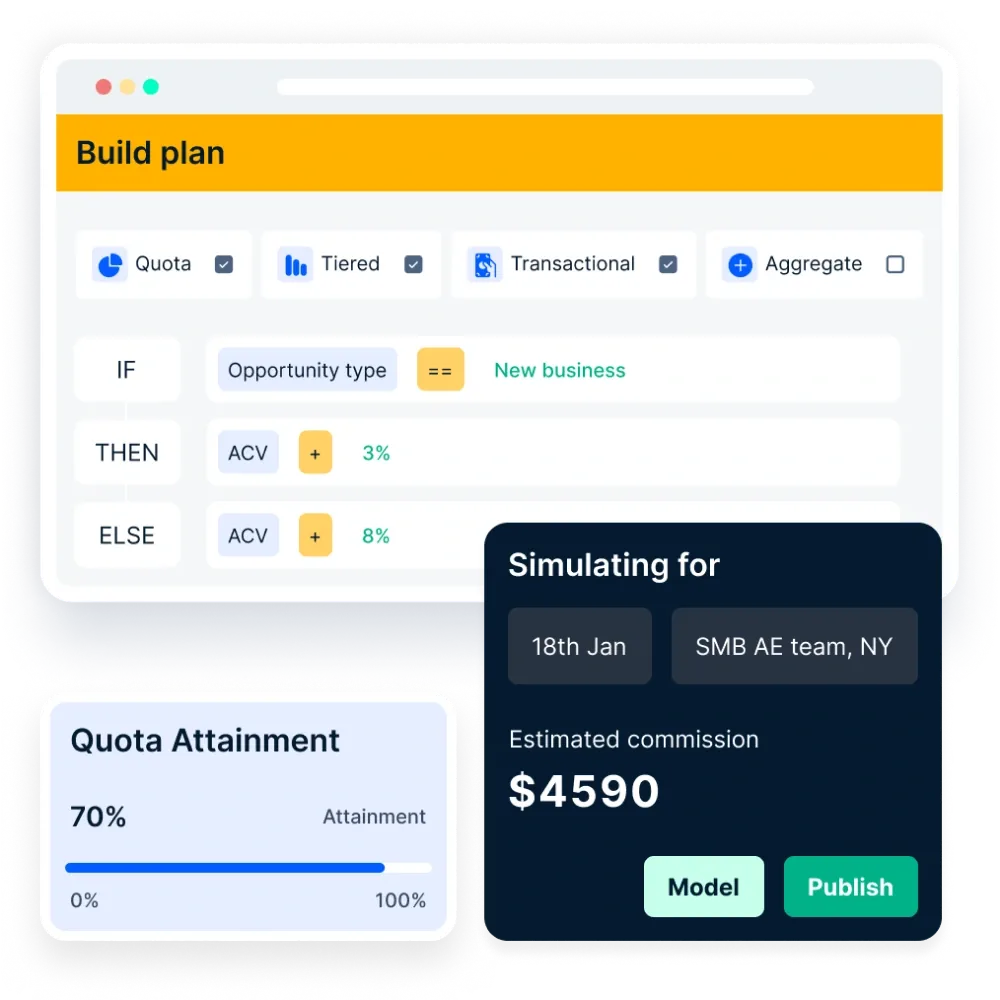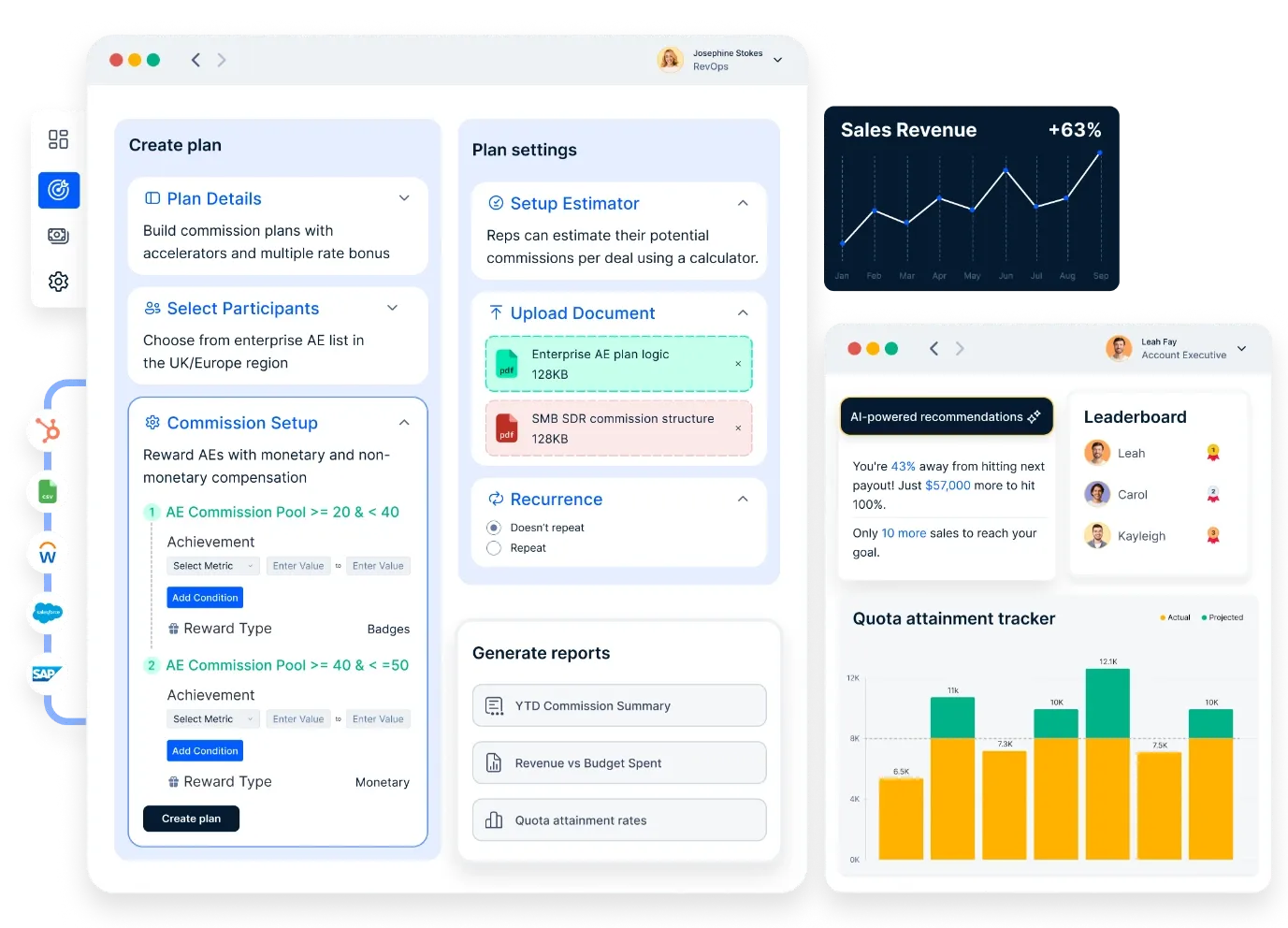Die 3 besten Vergütungspläne für Kundenbetreuer: Strategien zur Förderung der Kundenbindung und des Umsatzwachstums
Der Vergütungsplan für Kundenbetreuer zeigt auf, wie sich ihre Bemühungen in finanziellen Belohnungen niederschlagen und sie motivieren, bestimmte Ziele zu erreichen.
Auf dieser Seite
Die Vergütungspläne für Kundenbetreuer sind so gestaltet, dass sie ihrer einzigartigen Rolle bei der Förderung von Kundenbindung und -wachstum gerecht werden. Im Gegensatz zu Vertriebsfunktionen, die sich auf die Gewinnung neuer Kunden konzentrieren, konzentrieren sich Account Manager (AMs) und Customer Success Manager (CSMs) auf die Pflege bestehender Beziehungen, die Gewährleistung Kundenzufriedenheitund das Aufdecken von Möglichkeiten für Upselling und Cross-Selling.
Diese Konzentration auf die Kundenbindung ist von entscheidender Bedeutung, vor allem, wenn man bedenkt, dass es weitaus kosteneffizienter ist, Kunden zu halten, als neue Kunden zu gewinnen. Untersuchungen zeigen, dass es fünfmal so viel kostet, einen neuen Kunden zu gewinnen, als einen bestehenden Kunden zu halten. Außerdem kann eine Verbesserung der Kundenbindungsrate um nur 5 % den Gewinn um 25 % oder mehr steigern.
Angesichts der strategischen Bedeutung der Kundenbindung für ein nachhaltiges Wachstum müssen die Vergütungspläne für Kundenbetreuer deren entscheidenden Beitrag widerspiegeln. Dazu gehören Anreize, die an Kundenerfolgskennzahlen, Upselling-Bemühungen und allgemeine Zufriedenheit geknüpft sind, um langfristige Kundentreue und Rentabilität zu gewährleisten.
Ein effektiver Vergütungsplan für Kundenbetreuer ist ein Eckpfeiler für die Motivation von Kundenbetreuern, die Bindung bestehender Kunden und die Steigerung des Umsatzes.
Warum sind Festgehälter für Kundenbetreuer nicht geeignet?
Account-Management-Funktionen, wie Account-Manager und Account-Executives, bilden oft die Brücke zwischen Kundenbindung und Neukundengewinnung. Das durchschnittliche Grundgehalt für Kundenbetreuer in den USA liegt bei 70.000 Dollar jährlich, kann der angestrebte Verdienst (OTE) über 100.000 $ liegen.
Um das richtige Gleichgewicht zu finden, kombiniert ein umfassender Vergütungsplan Festgehälter mit variabler Vergütung, die Wachstumsboni, eine Provisionsstruktur und Anreize, die an die Beibehaltung des Nettoumsatzes oder an Verkaufsquoten gebunden sind, einschließt.
A gut strukturierter Vergütungsplan verringert nicht nur die Kundenabwanderung, sondern ermöglicht es dem gesamten Vertriebsteam, sich auf bestehende Kunden, kürzere Verkaufszyklen und zusätzliche Kundendienstleistungen zu konzentrieren, was letztlich das gesamte Umsatzwachstum steigert und die Rentabilität der Agentur gewährleistet.
Was sind die besten Vergütungspläne für Kundenbetreuer, um die Kundenbindung zu fördern?
Ein wettbewerbsfähiges Grundgehalt ist zwar wichtig, aber die besten Vergütungspläne für Kundenbetreuer zur Förderung der Kundenbindung konzentrieren sich auf Boni, die Anreize für das richtige Verhalten bieten:
Plan 1: Erhaltungsprovision
Dieser Vergütungsplan ist ideal für Kundenbetreuer, deren Hauptaufgabe darin besteht, bestehende Kunden zu halten. Kundenbetreuer werden auf der Grundlage ihrer Fähigkeit belohnt, Verträge zu verlängern und die Einnahmen aus bestehenden Kunden zu halten.
Ein Account Manager hat eine monatliche Retentionsquote von 35.000 $ ARR und verdient eine Provision von 12 % auf jeden Geschäftsabschluss.
- Behaltensabhängige Provision mit 1 Pfad zum Verdienst
- Vierteljährliche Nettoumsatzquote: $300,000
Verdienstregel:
- 0% - 100% = 7,5% Provisionssatz
- 100% - 150% = 12,5% Provisionssatz
- 150% = 15% Provisionssatz
Eine solche Vergütungsstruktur motiviert die Kundenbetreuer, sich auf die Bindung bestehender Kunden zu konzentrieren, was zur Erhaltung des Nettoumsatzes beiträgt und die Kundenabwanderung verringert.
Plan 2: Treue- und Upsell-Bonus
Dieser Plan berücksichtigt sowohl die Kundenbindung als auch das Kundenwachstum, indem Kundenbetreuer für Verlängerungen und Upsells belohnt werden. Er steht im Einklang mit strategischen Zielen wie der Steigerung des Customer Lifetime Value und der Erzielung von Geschäftswachstum.
Ein Account Manager hat eine vierteljährliche Retentionsquote von 250.000 $ ARR und verdient 9 % Provision für jede von ihm verwaltete Vertragsverlängerung. Zusätzlich hat er eine vierteljährliche Upsell-Quote von 80.000 $ ARR und verdient eine Provision von 12 % für jeden Upsell-Abschluss.
Treue- und Upsell-Bonus mit 2 Wegen zum Verdienst
1. Vierteljährliche Retentionsumsatzquote: 250.000 $
- 0% - 100% = 9% Bonus
- 100% - 150% = 12% Bonus
- 150% = 15% Bonus
2. Vierteljährliche Upsell-Umsatzquote: 80.000 $
- Gewinnregel: 12% Bonus
Dieser gut strukturierte Vergütungsplan stellt sicher, dass die Kundenbetreuer einen Anreiz haben, bestehende Kunden zu halten und gleichzeitig zusätzliche Möglichkeiten der Kundenbetreuung zu identifizieren, um das Gesamtumsatzwachstum zu steigern.
Plan 3: Prämie für die Mitarbeiterbindung
Bei diesem Ansatz werden Kundenbetreuer für das Erreichen bestimmter Umsatzbindungsziele mit festen Boni belohnt. Ein solcher Plan bietet finanzielle Sicherheit und fördert gleichzeitig die Konzentration auf den Erhalt von Kundenbeziehungen und die Reduzierung der Kundenabwanderung.
Ein Account Manager hat eine monatliche Retentionsquote von 40.000 $ ARR und verdient einen Bonus von 40 $ für jeden Prozentsatz seiner Quote, den er erfüllt.
- Bonus auf Basis der Mitarbeiterbindung mit 1 Pfad zum Gewinn
- Vierteljährliche Nettoumsatzquote: $300,000
Gewinnregel:
- 0% - 80% = $90 Bonus pro Prozentpunkt
- 80% - 100% = $110 Bonus pro Prozentpunkt
- 100% - 150% = $130 Bonus pro Prozentpunkt
- 150% = $150 Bonus pro Prozentpunkt
Ein umfassender Vergütungsplan wie dieser fördert die Motivation der Kundenbetreuer, stimmt mit den Unternehmenszielen überein und steigert die Nettoumsatzbindung. Eine regelmäßige Überprüfung der Vergütungspläne für den Vertrieb stellt sicher, dass sie die Unternehmensziele effektiv erreichen und das Umsatzwachstum fördern. Nehmen Sie dieses Handelsunternehmen als Beispiel.
Kundenbetreuer in derUnternehmen für Handelsproduktestehen vor der Herausforderung, bestehende Kunden zu halten und die Anzahl der an diese Kunden verkauften Produkte und Dienstleistungen zu erhöhen.
Die Lösung bestand darin, einen Bonusplan zu erstellen, der Account Executives für das Übertreffen von Zielen bei der Umsatzerneuerung, beim Verkauf neuer Produkte an bestehende Kunden, bei den Außenstandstagen und bei der Umsetzung des Key Account Plans belohnt. Die Ergebnisse werden in dem Dokument nicht erwähnt.
Das Unternehmen musste die Umsätze mit bestehenden Kunden steigern und neue Kunden gewinnen, die dem gewünschten Profil entsprachen. Außerdem wollte das Unternehmen die bestehenden Kunden halten und die Zahl der ihnen angebotenen Produkte/Dienstleistungen erweitern.
Es bestand die Notwendigkeit, Zeit in neue Märkte zu investieren und die bestehenden Kundenbeziehungen zu nutzen, um neue Kunden zu gewinnen. Um diese Herausforderungen zu bewältigen, entwickelte das Unternehmen einen umfassenden Vergütungsplan für Kundenbetreuer.
Außerdem wurden Teilnahmebedingungen festgelegt, um die Transparenz aufrechtzuerhalten, und es wurden Messgrößen auf der Grundlage der Leistung pro Einheit und der Art der Leistung verwendet. Darüber hinaus wurde ein Bonusplan für das Account Management eingeführt, der spezifische Boni für die monatliche Umsatzsteigerung und den Verkauf neuer Produkte vorsieht.
Es wurden Methoden für die Anrechnung von Umsätzen und die Aufteilung der Ziele unter den Teammitgliedern festgelegt. Als Ergebnis der Integration des Anreizprogramms, einschließlich des Vergütungsplans für Kundenbetreuer, bemerkte das Unternehmen für Handelsprodukte, dass die Bonusstruktur klare finanzielle Anreize für Kundenbetreuer bot, die sie ermutigten, ihre Ziele zu erreichen und zu übertreffen.
- Die Kundenbetreuer erhielten den maximalen Bonus von 6.000 US-Dollar, wenn sie eine perfekte Erneuerungsrate von 100 % erreichten.
- Mehrere Kundenbetreuer erhielten 1.000 Dollar, wenn sie mehrere neue Produkte an denselben bestehenden Kunden verkauften.
- Zusammenarbeit zwischen Vertriebsleitern und Kundenbetreuern.
- Verbesserte Kundenzufriedenheit und Vertragsverlängerungen.
An welcher Kennzahl können Sie Ihre AM-Vergütungspläne ausrichten?
Die beste Kennzahl für Ihren AM-Vergütungsplan hängt von den Zielen Ihres Unternehmens ab.
Wenn Sie der Kundenbindung Priorität einräumen wollen, dann sollten Sie das tun:
Versuchen Sie, den GRR-Plan (Gross Revenue Retention) umzusetzen. Die Kennzahl für diesen Plan konzentriert sich ausschließlich auf die Beibehaltung des bestehenden Umsatzstroms aus Ihrem bestehenden Kundenpool.
Indem Sie diese Kennzahl in den Vergütungsplan für Kundenbetreuer einbeziehen, können Sie die Kundenbetreuer danach belohnen, wie gut sie die Kundenabwanderung in Schach halten. Eine solche Methode würde sicherstellen, dass die Kundenbetreuer den Anstoß erhalten, die bestehenden Verträge zu verlängern.
Nehmen wir an, die vierteljährliche Quote beträgt 300.000 $ in GRR. Wenn sie also 80 % oder mehr der Quote erreichen, erhält der Kundenbetreuer einen Bonus in der von Ihnen festgelegten Höhe. Zum Vergleich: Die Struktur beträgt 125 $ pro 1.000 $ GRR, die über die Quote hinausgehen.
Wenn Sie dem Kundenwachstum Priorität einräumen wollen, dann sollten Sie das tun:
Verwenden Sie die NRR oder Net Revenue Retention. Damit werden AMs sowohl für die Bindung bestehender Kunden als auch für die Steigerung des Umsatzes durch Upsells und Erweiterungen belohnt. Die Verknüpfung der NRR mit dem Vergütungsplan für Account Manager würde die AMs dazu veranlassen, sich für Upselling-Möglichkeiten zu öffnen.
Diese Kennzahl berücksichtigt die Kundenbindung und Upselling-Möglichkeiten. Auf diese Weise können Sie bestehende Kunden an sich binden und sie ermutigen, ihre Service-Abonnements zu erweitern oder zusätzliche Produkte zu kaufen. Diese Art von Kennzahl birgt das Potenzial, den Gesamtumsatz zu steigern.
Net Revenue Retention berücksichtigt die Einnahmen von bestehenden Kunden. Dieser Vergütungsplan bietet Anreize für das Übertreffen von Zielen. Angenommen, die vierteljährliche Quote beträgt 300.000 $. Ihr Leistungsbonus beträgt 125 $ pro Prozentpunkt, der über der Quote liegt. Übertrifft ein AM beispielsweise seine Quote um 20 %, erhält er einen Bonus von 2.500 $ (125 x 20).
Wenn Sie ein Gleichgewicht zwischen Wachstum und Kundenbindung anstreben, sollten Sie einen kombinierten Plan für die Brutto- und Nettoeinnahmenbindung verwenden:
Dieser kombinierte Ansatz motiviert die AMs, in beiden Bereichen erfolgreich zu sein. Es gibt einige Elemente, die auch zur Aufrechterhaltung der Leistung des AM eingesetzt werden könnten. Sie sind:
- Erreichen der Quote:Damit wird die Fähigkeit des AM gemessen, eine bestimmte Menge an Einnahmen oder Verkäufen innerhalb eines festgelegten Zeitrahmens zu erzielen.
- Kundengewinnungskosten (CAC):Ein niedriger CAC zeigt an, dass der AM effizient neue Kunden anwirbt.
- Kundenlebensdauerwert (CLTV):Diese Kennzahl belohnt AMs für die Gewinnung von Kunden, die dem Unternehmen einen langfristigen Wert bringen.
- Kundenbindungsrate:Eine hohe Kundenbindungsrate ist ein Zeichen dafür, dass es AM gelingt, bestehende Kunden zufrieden zu stellen.
Ziehen Sie einen ausgewogenen Ansatz in Erwägung, der verschiedene Kennzahlen kombiniert. Lassen Sie uns erläutern, wie diese weltweit anerkannte Luxus-Automarke einen gut strukturierten Vergütungsplan für das gesamte Team eingeführt hat, der zu ihrem Gesamterfolg mit einer 96,2 %igen Steigerung der Auszahlungsquote geführt hat.
Wir haben nun die wichtigsten Kennzahlen zur Bewertung der Leistung von Kundenbetreuern ermittelt.Lassen Sie uns nun erörtern, wie man einen umfassenden Vergütungsplan für Kundenbetreuer erstellt.
Wie erstellt man die besten Vergütungspläne für Kundenbetreuer?
Die Gestaltung eines erfolgreichen Vergütungsplans für Kundenbetreuer ist entscheidend für das Erreichen Ihrer Unternehmensziele und die Motivation Ihrer Kundenbetreuer. Hier erfahren Sie, wie Sie einen gut strukturierten Vergütungsplan erstellen können:
1. An den Unternehmenszielen ausrichten
Ihr Vergütungsstrategie sollte die Ziele Ihrer Vertriebsorganisation direkt unterstützen. Unabhängig davon, ob Sie sich auf Kundenbindung, Umsatzwachstum oder die Gewinnung neuer Kunden konzentrieren, muss Ihr Vergütungsplan für Kundenbetreuer Anreize für Maßnahmen schaffen, die mit diesen Zielen übereinstimmen.
2. Größe und Komplexität des Kontos
Größere oder komplexere Kunden erfordern mehr Zeit und Aufwand für die Verwaltung. Stellen Sie sicher, dass Kundenbetreuer, die einen hohen Jahresvertragswert oder komplizierte Kundenbedürfnisse betreuen, besser entlohnt werden als diejenigen, die kleinere Kunden betreuen.
3. Maßgeschneidert für Erfahrung
Erfahrene Kundenbetreuer oder Senior Account Manager bringen oft einen höheren Wert durch kürzere Verkaufszyklen, Kundenbindung und zusätzliche Kundendienste. Berücksichtigen Sie dies in ihrem Grundgehalt, ihrer variablen Vergütung oder ihren Wachstumsboni.
Compass kann den AM-Vergütungsplan erheblich verbessern, indem es Ihnen ermöglicht, den Entwurf Anreizvergütung Pläne testen können, bevor sie in Kraft treten. Mit der leistungsstarken Modellierung von Was-wäre-wenn-Szenarien können Sie analysieren, wie sich die verschiedenen Rollen auswirken werden.
Darüber hinaus können Sie mit Compass erfolgreiche Vergütungspläne analysieren und nachbilden, die in der Vergangenheit zu einer erhöhten Erreichung der Quote und maximaler Rentabilität geführt haben. Das bedeutet, dass Sie wirksame Strategien einfach nachbilden können.

Sie können Ihre Incentive- oder Provisionspläne jederzeit an die sich ändernden Markttrends und Umsatzzielen anpassen und so sicherstellen, dass Ihre Vergütungsstrategie relevant und effektiv bleibt.
4. Wettbewerbsfähige Vergütungspläne
Vergleichen Sie Ihre Vergütungsprogramme mit den Branchenstandards. Mit wettbewerbsfähigen Festgehältern, zielgerichteten Verdiensten und Provisionen können Sie Spitzenkräfte für Ihr Vertriebsteam gewinnen und an sich binden.
5. Klare Kommunikation
Erklären Sie klar und deutlich die Provisionsstruktur, die Erneuerungsquote und die Wachstumsboni. Ein umfassender, leicht verständlicher Vergütungsplan wird die Kundenbetreuer in die Lage versetzen, die Erwartungen zu übertreffen.
6. Saisonalität und Verkaufszyklen
Berücksichtigen Sie Schwankungen bei den Verkaufszyklen und Verlängerungen. Bieten Sie in schwächeren Zeiten Anreize, um die Motivation und die Vertriebseffizienz aufrechtzuerhalten. Ziehen Sie Boni in Betracht, die an kürzere Verkaufszyklen oder zusätzliche Kundendienste in Schwachlastzeiten gebunden sind.
7. Regelmäßige Überprüfungen und Anpassungen
Bewerten Sie regelmäßig Ihre Vergütungspläne. Faktoren wie die Länge des Verkaufszyklus, die Kundenabwanderung und der erzielte Umsatz sollten die Grundlage für notwendige Aktualisierungen bilden, damit der Plan effektiv bleibt und mit den Unternehmenszielen übereinstimmt.
Wenn Sie diese Elemente berücksichtigen, können Sie motivierende Vergütungspläne erstellen, die Anreize für Kundenbetreuer schaffen, das allgemeine Umsatzwachstum fördern und die Ausrichtung an den Umsatzzielen des Unternehmens sicherstellen.
Bewährte Verfahren für den Vergütungsplan für Kundenbetreuer
Wir werden Best Practices entwickeln, indem wir Fallstudien analysieren, uns auf deutsche Luxusautohersteller konzentrieren und die Bedürfnisse von kommerziellen Produktorganisationen berücksichtigen.
Von dem globalen Unternehmen für Handelsprodukte haben wir gelernt:
- Ausrichtung der Vergütung der Kundenbetreuer an den Unternehmenszielen. Das Unternehmen gestaltete den Vergütungsplan für die Kundenbetreuer so, dass er mit den Hauptzielen des Unternehmens übereinstimmte, zu denen die Bindung bestehender Kunden, die Ausweitung des Verkaufs neuer Produkte an bestehende Kunden und die Verbesserung der Außenumsatztage gehörten. Dies half dem Unternehmen sehr, den Kundenbetreuern die Vergütung zukommen zu lassen, die sie brauchten, um sich durchzusetzen.
- Aggressive Umsetzung von Großkundenplänen. Indem die Prämien für die Kundenbetreuer an diese Kennzahlen geknüpft wurden, bot der Plan Anreize für Verhaltensweisen, die die Gesamtstrategie des Unternehmens unterstützten.
- Erstellen Sie eine gründliche Bonusstruktur. Das Unternehmen für Handelsprodukte stellte einen strukturierten Bonusplan auf, der Teilnahmebedingungen zur Aufrechterhaltung der Transparenz, Kennzahlen auf der Grundlage der Leistung von Einheiten und Leistungsarten sowie spezifische Boni, die an die monatliche Umsatzsteigerung und den Verkauf neuer Produkte geknüpft waren, umfasste. Darüber hinaus wurden Methoden zur Gutschrift von Umsätzen und zur Aufteilung der Ziele unter den Teammitgliedern eingeführt. Die Strukturierung der Boni mit festen Regeln bot klare finanzielle Anreize für die Kundenbetreuer, ihre Ziele zu erreichen und zu übertreffen.
Wenn Sie die bewährten Verfahren für den Vergütungsplan für Kundenbetreuer beibehalten, werden Sie das merken:
- Verbesserte Zusammenarbeit zwischen Vertriebsmitarbeitern und Kundenbetreuern
- Kundenzufriedenheit und Vertragsverlängerungen, wie durch das Unternehmen für kommerzielle Produkte und die deutsche Luxusautomarke festgestellt wurde, die eine 96%ige Compass verzeichnete.
- Die Bonusstruktur motivierte die Kundenbetreuer effektiv, sich auf Erneuerungen, Upsells und Kundenbeziehungen zu konzentrieren, was zu besseren Geschäftsergebnissen für das Unternehmen führte.
Schlussfolgerung
Die Vergütungspläne für den Vertrieb sollten die Kundenbetreuer dazu motivieren, mehr Kunden zu gewinnen. Dies kann durch eine Vergütungsstruktur erreicht werden, die das Wachstum der Kunden belohnt, und indem sichergestellt wird, dass die Pläne klar und detailliert sind.

Der Weg zum Wachstum beginnt damit, dass die Vertriebsleiter erkennen, wo und wie die Vertriebsanstrengungen nicht ausreichen, um geeignete Änderungen am Vergütungsplan für Kundenbetreuer zu ermitteln und umzusetzen. Dies kann durch die Bewertung der aktuellen Vertriebsleistung bei Verlängerungen, Cross-Sells/Upsells und neuen Umsätzen im Vergleich zu den Prognosen und Wachstumszielen geschehen. Implementieren Sie daher einen Accelerator wie Compass zu:
- Automatisieren Sie das Anreizprogramm. Diese Automatisierung hilft, Fehler und Verzögerungen im Zusammenhang mit manuellen Prozessen zu vermeiden.
- Erhalten Sie Einblicke in die Leistung in Echtzeit. Erhalten Sie Einblicke in Leistungskennzahlen und Provisionsinformationen.
- Erstellen Sie einen flexiblen Vergütungsplan für Ihre Kundenbetreuer. Compass kann sowohl mit einfachen als auch mit komplexen Vergütungsstrukturen umgehen und lässt sich so an verschiedene Geschäftsanforderungen anpassen.
Zuletzt, Compass schließlich bietet prädiktive Analysen und leistungsstarke Einblicke, damit Unternehmen teamübergreifend besser planen und fundierte Entscheidungen über Vergütungsstrategien treffen können. Vereinbaren Sie also einen Demo-Anruf mit unseren Spezialisten, um herauszufinden, wie Sie einen perfekten Vergütungsplan für Ihre Kundenbetreuer erstellen können.
FAQs
1. Wie sollten die Kundenbetreuer entlohnt werden?
Kundenbetreuer sollten eine Vergütungsstruktur haben, die ein Gleichgewicht zwischen Grundgehalt und leistungsbezogenen Anreizen herstellt. Ein wettbewerbsfähiges Grundgehalt sorgt für finanzielle Stabilität, während Boni oder Provisionen in Verbindung mit Kundenbindung, Upselling, Cross-Selling und Kundenzufriedenheit die Leistung steigern. Darüber hinaus erhöht das Angebot nicht-monetärer Leistungen wie z. B. berufliche Entwicklungsmöglichkeiten die Motivation.
2. Wie sieht der Vergütungsplan für einen Kundenbetreuer aus?
Der Vergütungsplan eines Kundenbetreuers umfasst in der Regel ein Grundgehalt plus Provisionen. Die Provisionen sind oft an das Erreichen oder Übertreffen von Verkaufszielen, die Gewinnung neuer Kunden oder das Upselling bestehender Kunden gebunden. Anreize wie Boni für das Übertreffen von Quoten oder Teamleistungen können ebenfalls enthalten sein..
3. Wie verdienen die Kundenbetreuer ihre Provisionen?
Provisionen werden durch das Erreichen oder Übertreffen von Umsatzzielen, Upselling, Cross-Selling oder die Bindung von Großkunden verdient.
4. Bekommt ein Kundenbetreuer eine Provision?
Ja, Kundenbetreuer erhalten oft Provisionen für das Erreichen von Kundenbindungs-, Upselling- oder Cross-Selling-Zielen.
5. Wie ist die Provisionsstruktur für Kundenbetreuer?
Account Executives verdienen in der Regel einen Prozentsatz des Umsatzes, wobei höhere Sätze für die Akquisition neuer Kunden, größere Geschäfte oder das Übertreffen von Quoten gelten. Einige Pläne enthalten gestaffelte Provisionssätze.













